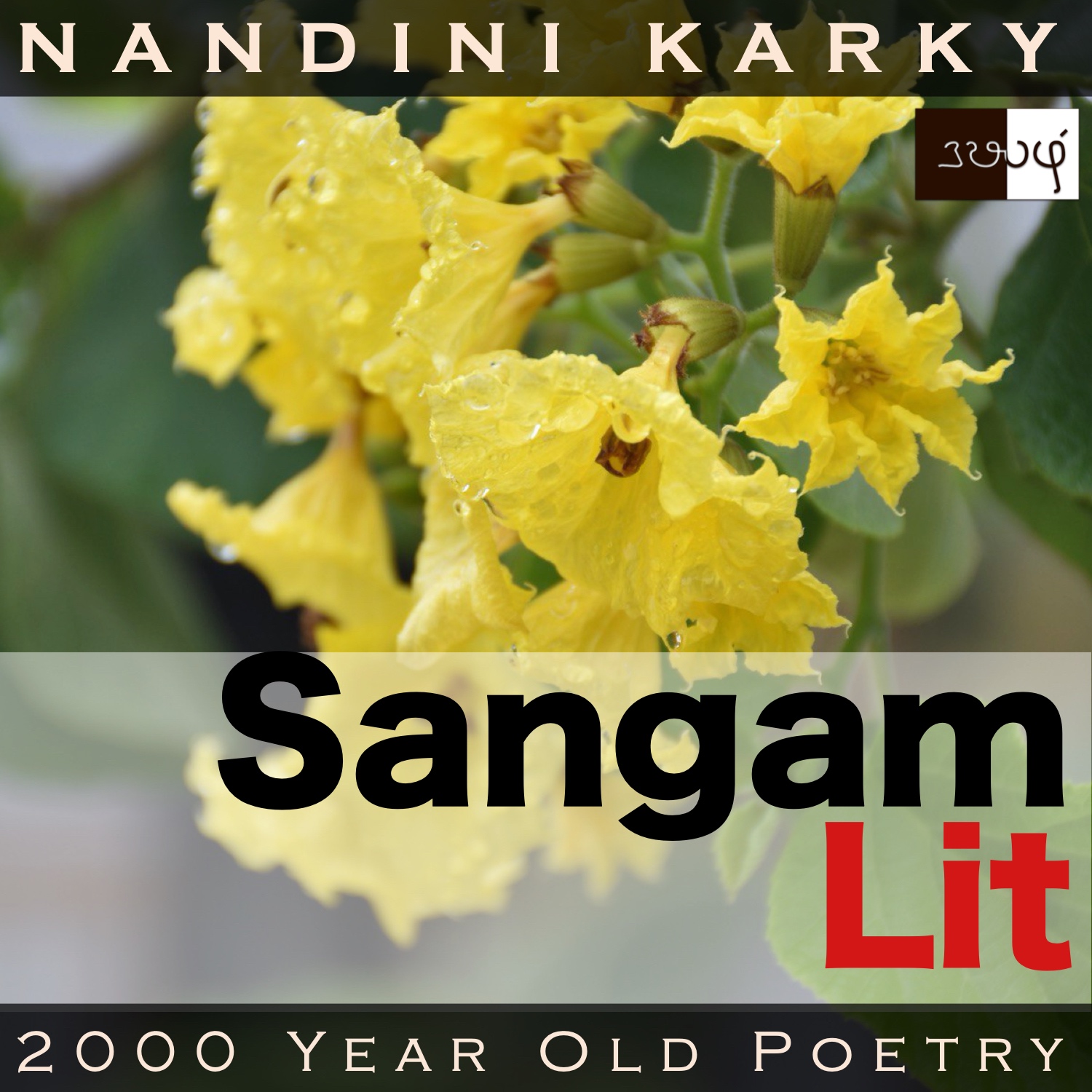Podcast: Play in new window | Download
Subscribe: Apple Podcasts | Spotify | Amazon Music | Android | iHeartRadio | TuneIn | RSS | More

In this episode, we relish references to flowers in a mountain country, as portrayed in Sangam Literary work, Natrinai 313, penned by Thankaal Porkkollan Vennaakanaar. Set in the hills of ‘Kurinji’, the verse speaks in the voice of the confidante to the lady, passing on a hidden message to the man, listening nearby.
கருங் கால் வேங்கை நாள் உறு புதுப் பூ,
பொன் செய் கம்மியன் கைவினை கடுப்ப,
தகை வனப்புற்ற, கண்ணழி கட்டழித்து,
ஒலி பல் கூந்தல் அணி பெறப் புனைஇ,
காண்டற் காதல் கைம்மிக கடீஇயாற்கு
யாங்கு ஆகுவம்கொல்?-தோழி!-காந்தள்
கமழ் குலை அவிழ்ந்த நயவருஞ் சாரல்
கூதள நறும் பொழில் புலம்ப, ஊர்வயின்
மீள்குவம் போலத் தோன்றும்-தோடு புலர்ந்து
அருவியின் ஒலித்தல் ஆனா,
கொய்பதம் கொள்ளும், நாம் கூஉம் தினையே.
The verse opens with ‘கருங் கால் வேங்கை’ meaning ‘black-trunked Indian Kino tree’ and invites us with a vision of this celebrated tree in a mountain forest. The phrase ‘பொன் செய் கம்மியன்’ brings to the fore, ‘a goldsmith’ of those times and as his name indicates, the poet of this song was one too. Interesting to know how a person could be a carver of gold and a weaver of words, at the same time! Perhaps, being a poet was not the only profession of those Sangam poets. Moving on to the verse, we find a reference to the ‘thick tresses of the lady’ in ‘ஒலி பல் கூந்தல்’. In addition to the Kino tree and its flowers, we also get to see the ‘காந்தள் கமழ் குலை’ meaning ‘the fragrant clusters of the flame lily’ and the ‘கூதள நறும் பொழில்’ meaning ‘groves wafting with the scent of the nightshade’. A floral delight for the senses! Ending with ‘நாம் கூஉம் தினையே’ meaning ‘the millet fields that we protect’, the verse beckons us to take a walk on this mountain path.
The man and lady had been leading a love relationship and the man had been trysting with the lady in the millet fields for a while. One day, when he comes by to the millet fields, pretending not to notice him, but making sure he is listening, the confidante says to the lady, “Making an exquisite garland from the timely, new flowers of the black-stemmed ‘vengai’, which glow akin to the workmanship of a goldsmith, and removing the knots of your unmanageable, luxuriant tresses, he decorates it with the garland and delights in that sight! He, who helped you chase away parrots, the one filled with immense love for you… What can we do for him now, my friend? Leaving these charming mountain slopes, wherein fragrant clusters of the ‘kaanthal’ open their buds and these groves filled with the scent of ‘koothalam’ vines, all alone, we are soon to return to our hamlet, for the millet stalks have dried up and resound like a cascade, taking on the texture for a harvest… Those very millets in the field we protected by chasing away parrots!” With these words, the confidante informs the man that the days of his carefree trysting was over as the lady was to be confined to her house and the only way to enjoy her company was to seek the lady’s hand in marriage.
Now, for the nuances! The confidante starts her conversation by pointing out to the Kino tree’s seasonal flowers that have bloomed in all the branches and to highlight the sight of these flowers, she brings in a simile. The flowers glow on the tree akin to a goldsmith’s workmanship, she says. It’s not only the creativity in this thought that glitters, but also the essence of the information about these flowers. The season when these ‘vengai’ flowers bloomed was important to those mountain folks in many ways, which we will delve into, in a short while. Before we do, let us follow the confidante, who has referred to the Kino tree’s flowers as if only to say that the man takes those golden flowers and makes a head garland out of it, and ties it around the lady’s thick and flowing tresses. He takes much pleasure in the vision of the lady and is filled with love for her. Then, the confidante adds a twist to this charming scene asking, ‘what will happen to him now?’
When we are wondering what that’s all about, the confidante clarifies saying that’s because all signs seemed to indicate that they will be confined to the house in their little hamlet, leaving those fragrant mountain slopes and groves, filled with flowers such as the flame-lily and the nightshade, all alone. Why this sudden change in their life? It’s because the millet stalks have grown and lost their youthful moisture and are now rustling like a waterfall. All this announces to the world that the harvest is soon to be done in that millet field that the lady has been guarding this far. To understand this poem better, we have to delve into the social customs of then. A young mountain girl was given the task of chasing away parrots in the millet field. But, soon the crops mature and the season of harvest is near, which means the lady’s work is done and that she will return to her house in the village. The arrival of the harvest season is further revealed by the blossoming of the Kino trees, which we saw in the beginning. It was also the custom of Sangam folks to conduct marriages in this season, when the Kino tree bursts forth its gold. With all these references, the confidante is subtly persuading the man to seek the blessings of the elders and formalise his union with the lady. A pleasant walk through the forests, delighting in the sights and scents of these flowers that seems to have meant much to the people of then!




Share your thoughts...